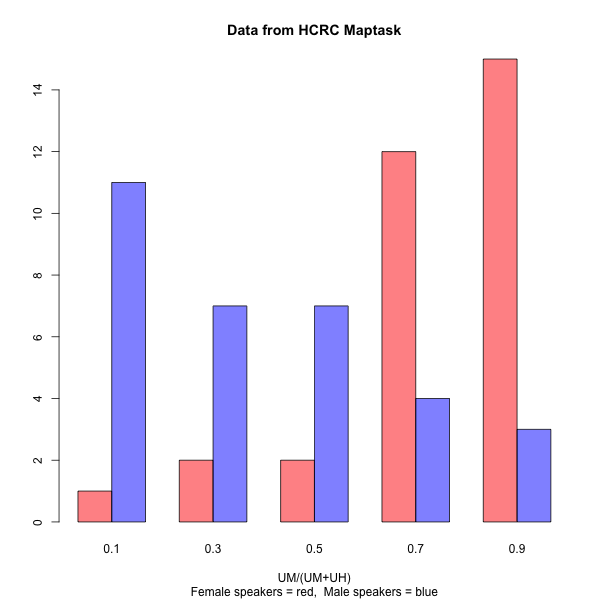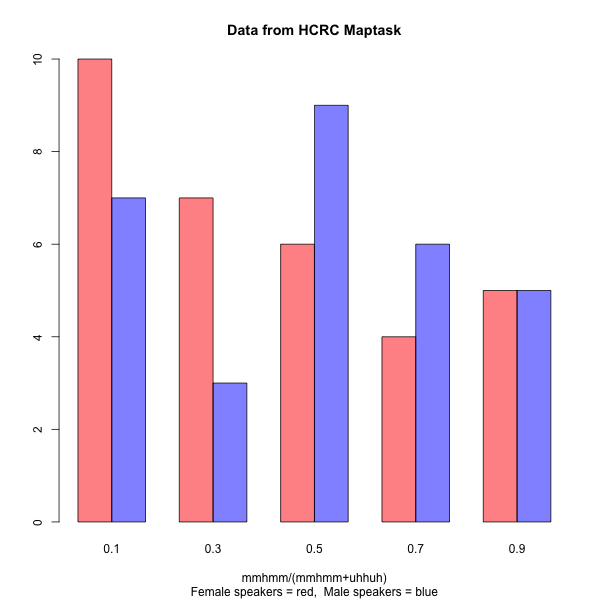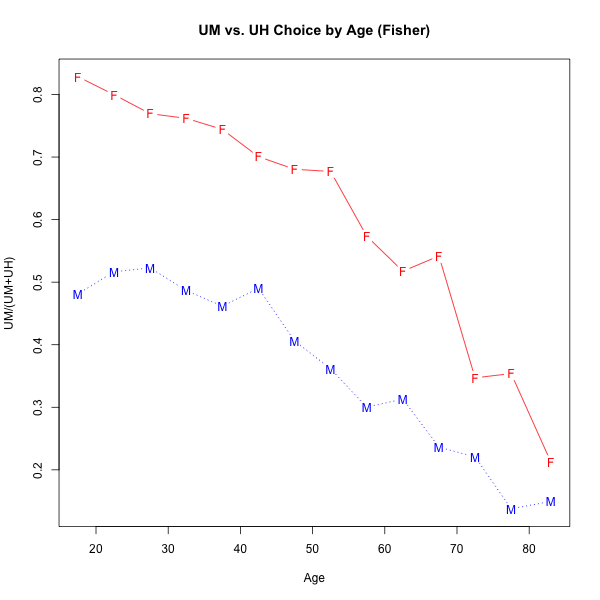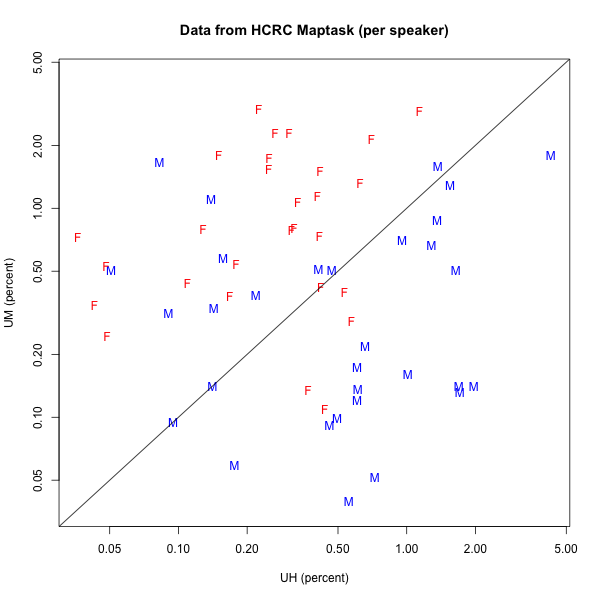Labiality and femininity
« previous post | next post »
 I recently got this note from Bill Labov, following up on a conversation about UM and UH (see "UM / UH update", 12/13/2014, for a summary),
I recently got this note from Bill Labov, following up on a conversation about UM and UH (see "UM / UH update", 12/13/2014, for a summary),
I've been thinking about the female preference for the labial gesture in hesitation forms, and this returned me to the issues raised by Gordon and Heath in their paper on sex and sound symbolism (Matthew Gordon and Jeffrey Heath, "Sex, Sound Symbolism, and Sociolinguistics", Current Anthropology 1998). I think it's an important contribution because it brings in quite a bit of data on general patterns of sex preference and it's well reviewed by the commentators. I've always been interested in G&H's efforts to explain the general principles of chain shifting that I've extracted.
Gordon and Heath develop the notion of sex differentiation by sound symbolism on an acoustic basis. I'm more inclined to look to articulatory factors, associating the female preference for movement to more peripheral vowels with the expressive gestures of lip spreading and lip rounding. These are associated with fronting and backing somewhat more than with raising. So the preference for um might go along with the female orientation to labial gestures.
This idea — that UM preference might reflect a kind of performative femininity — was one of the first things that occurred to me when I noticed the effect ("Young men talk like old women", 11/6/2005). My point of reference was work by Niloofar Haeri, for instance her paper "'Why do women do this?' Sex and Gender Differences in Speech" (1996), which looks at the gender association of sound changes that involve vowel fronting and backing:
On the basis of these data, from 10 different speech communities, it is reasonable to generalize that fronting has the iconic value 'female,' while backing has the iconic value 'male', Put differently, we could say that fronting is an expressive posture more often exhibited by women, while backing is an expressive posture more often exhibited by men.
It's plausible that there might be a similar unconscious iconic value in labiality. But a phonetic-symbolism hypothesis doesn't explain why there's also a strong age effect: younger people tend to use UM more and UH less, regardless of sex, as illustrated in this data from the (American English) Fisher conversational speech corpus:
Still, there might be something there — we could make up a story about greater accommodation to female speech on the part of younger males, or the gradual waning of maternal influence, or a sound-change-in-progress with women in the lead (for which there is actually some evidence), or something.
Anyhow, it occurred to me that there are some other places we could look for similar effects. For example, English has a range of quasi-lexical signals of assent and dissent, of the form
| Assent | X hX |
| Dissent | ʔX ʔX |
…where X can be a neutral vowel (roughly of the STRUT lexical set, at least for most Americans), or alternatively a syllabic nasal, which is usually [m] (or at least written so — and I think that the versions with a coronal or velar nasal, though possible, are much less common, at least for the signal of assent). The oral version of the assent signal is generally written something like "uh huh", while the nasal version is generally written something like "mm hmm".
(Note that the positive signal, which I've labelled "Assent", is often used simply as a back-channel response to indicate uptake rather than agreement.)
Since these two versions are in the same sort of quasi-free-variation as UM and UH, we might expect that any sex-sound-symbolism forces that are influencing the UM/UH choice would also influence the MMHMM/UHHUH choice. And it happens that the HCRC Map Task data makes this easy to look into.
The "map task" corpus is a collection of task-oriented dialogs, collected at Glasgow University in 1992. In each interaction, a "guide" instructs "follower" in how to draw a route on a map. The subjects were 32 male and 32 female university students, who each participated in two interactions, once as guide and once as follower. A detailed description of the collection can be found here. The point of current relevance is that assenting signals of one kind or another are very common, and in particular there are thousands of instances of (what the map task transcribers spelled) "uh-huh" and "mmhmm".
The map task dataset exhibits the expected sex effect on UM/UH choice (where UM may be spelled "ehm", "erm", "mm", or "um", and UH may be spelled "eh", "er", or "uh"):
| Males | Females | |
| UM | 389 | 706 |
| UH | 677 | 215 |
| UM+UH | 1066 | 921 |
| UM % (of UM+UH) |
36.5% | 76.7% |
| Filled Pause % (of all words) |
1.31% | 1.27% |
Across the 32 male and 32 female speakers, a histogram of UM percentages (100*UM/(UM+UH) looks like this:

Or as a scatter plot of individual UH and UM rates:
OK, so what does the distribution of assenting-signal forms look like?
| Males | Females | |
| mmhmm | 337 | 557 |
| uh-huh | 381 | 1079 |
| mmhmm+uh-huh | 718 | 1636 |
| mmhmm % (of mmhmm+uh-huh) |
46.9% | 34.0% |
| X hX % (of all words) |
0.88% | 2.25% |
This tends to disconfirm the phonetic-symbolism hypothesis: Female speakers are actually less likely (than male speakers are) to choose the labial-nasal form of the signal as opposed to the neutral-vowel version. Female speakers choose the labial-nasal form 34.0% of time, while male speakers choose that form 46.9% of the time. The biggest effect is that female speakers are much more likely to use both of the forms, compared to male speakers — an overall rate of 2.25% of all words used, compared to 0.88%. I'm not sure why this is — other choices for verbalizing assent (or uptake) in this dataset are more balanced, or break the other way, e.g.
| Males | Females | |
| okay (% of all words) |
1196 (1.47%) |
1262 (1.74%) |
| yeah (% of all words) |
988 (1.21%) |
722 (1.00%) |
| yes (% of all words) |
221 (0.27%) |
79 (0.11%) |
| SUM (% of all words) |
2405 (2.96%) |
2063 (2.84%) |
Here's a histogram of mmhmm proportions (mmhmm/(mhmm+uhhuh) across speakers:

And presented as a scatter plot:

This doesn't by any means disprove the phonetic symbolism theory — but it certainly doesn't support it.


Kyle Gorman said,
December 26, 2014 @ 5:15 pm
I must confess I don't share others' feelings that this hypothesis is a priori likely—sound symbolism seems to be a rather peripheral fact about language, all things considered, and the hypothesized direction of the effect is not at all self-evident to me—but thanks for doing this careful test.
Rubrick said,
December 26, 2014 @ 5:35 pm
I'm now starting to wonder whether there's a strong Geoff ↔ Linguist correlation.
Bob Ladd said,
December 26, 2014 @ 5:47 pm
I don't find the sound symbolism idea implausible at all, but I'm not sure the mmhmm-vs.-uhhuh comparison is actually parallel to um-vs.-uh. In the assent/backchannel, the key common feature is NASALITY, and the difference between mmhmm and uh-huh is whether you open your mouth or not. In the filled-pause sound, the key common feature is a (non-nasal) SCHWA, and the difference between um and uh is whether you add a labial gesture or not. Hence the possibility of treating the labial gesture as something independently meaningful or sound-symbolic.
(Potential problem with this account: at least some Scottish speakers have a noticeably NON-nasalised uh-huh, and of course the HCRC Map Task speakers were almost all speakers of Scottish English. Unfortunately, the transcriptions won't help to determine whether any given uh-huh was nasalised or not.)
Paul Kay said,
December 27, 2014 @ 12:39 pm
I wonder whether the hypothesis of labiality as an icon of femininity might be pursued by comparing in men's and women's recorded speech things like the voice timing of initial b's and m's, also perhaps as paired with the accompanying visual gestures of the lips. For example, one might ask whether either sex, as compared to the other, elongates initial m's , or purses the lips longer before the onset of voicing of an initial m, or extends the lips further. My completely unscientific impression is that some of this might be true at least of deliberately hyper-feminine performances, like Marilyn Munroe's.
[(myl) An interesting idea. It's easy to check, at least insofar as TIMIT provides data. Here are the mean durations in milliseconds from that source:
m bcl pcl n dcl tcl ng gcl kcl Male 59.9 64.4 70.6 53.6 51.6 55.0 61.1 49.7 59.7 Female 64.0 62.1 67.6 55.9 49.7 52.8 66.0 51.1 60.3N is big enough that even mean differences of a few milliseconds are often statistically (though of course not functionally) significant, e.g. (for instance) the general tendency for female nasal murmurs to be 2-5 msec longer on average. But there's no such effect for labiality.]
Rottweiler said,
December 29, 2014 @ 4:30 am
It seems to me that women, at one point in time, needed to attract a mate as a survival option and to pass on their genes but all seems murky in today's society. Being able to live a whole but no necessarily 'whole' life with just the same sex partner and being able to effectively order up a baby humanity needs to take a hard look at humanities future I think.
Roger Lustig said,
December 29, 2014 @ 10:54 am
Hmm… http://www.nytimes.com/2014/12/27/business/international/adidos-and-hotwind-in-china-brands-evoke-foreign-names-even-if-theyre-gibberish.html (referred to in the Biemlfdlkk thread) mentions a Chinese whiskey called Johnny Worker Red Labial.
[(myl) Thus bringing alcohol and class divisions into the discussion. As I recall, years of education (which is a crude proxy for S.E.S.) correlates with higher rates of UM usage in Fisher; but blood alcohol content is not available in the Fisher metadata.]